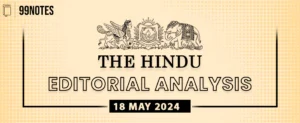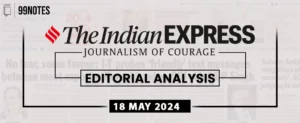Topic: GS3 – Internal Security – Linkages between development & spread of extremism This topic is relevant for Mains as the analysis delves into the underlying socio-economic factors fueling Naxalism. |
| Context: |
|
Decline of Maoist Influence:
- The Maoist movement, which peaked in 2010, has witnessed a decline in violence and geographical spread.
- Prime Minister Manmohan Singh previously identified Left-wing extremism (LWE) as the gravest internal security threat to the nation.
- However, heavy deployment of central armed police forces and the implementation of national policy and action plans have led to a consistent decline in violence and the constriction of Maoist influence.
- Minister of State for Home Affairs Nityananda Rai highlighted a 73% reduction in violence since 2010 and a decrease in the number of police stations reporting LWE-related violence.
Surrenders and Government Statements:
- Sustained pressure on Naxalites has resulted in a significant number of surrenders over the years, with approximately 16,780 Naxalites surrendering between 2000 and 2024.
- Home Minister Amit Shah and other officials have expressed optimism about combating the Naxal issue, with promises to eradicate the problem within specific timeframes.
- However, despite government efforts and declarations, the problem persists.
Challenges and Flaws in Approach:
- The government’s approach to tackling the Naxal problem faces several challenges and flaws.
- There is a lack of an overall strategic plan, leading to varying approaches by different states.
- Moreover, states often perceive LWE as a national problem, passing responsibility to the central government.
- Until state forces take the lead in anti-Naxal operations, with central armed police forces playing a subsidiary role, the issue may not be conclusively resolved.
Whole-of-Government Approach and Environmental Factors:
- A whole-of-government approach is lacking, with security forces unable to sustain cleared areas without proper administration and infrastructure development.
- Additionally, fundamental problems such as deforestation and tribal displacement contribute to the Naxal issue.
- The ambiguity in the definition of “forest” in the Forest Conservation Act’s amendment of 2023 may further exacerbate environmental and social issues.
Economic Inequality and Peace Dialogue:
- The extreme levels of economic inequality, as highlighted by the World Inequality Lab, add another layer to the Naxal problem.
- With the government having the upper hand, there is an opportunity to initiate peace dialogue with Naxal leadership.
- Such dialogue should not be seen as a sign of weakness but rather as a magnanimous effort to resolve the conflict peacefully.
- Drawing parallels with peace talks in the Northeast, it is time to mainstream tribals and address their grievances instead of seeking to defeat them.
Conclusion:
- While security forces have achieved significant victories against the Maoists, the underlying issues driving the conflict remain unresolved.
- A comprehensive and coordinated approach involving both security measures and socio-economic initiatives is necessary to address the root causes of the Naxal problem and achieve lasting peace in Central India.
| Ways to end Naxalism in India |
Good governance:
|
| PYQ: The persisting drives of the government for development of large industries in backward areas have resulted in isolating the tribal population and the farmers who face multiple displacements with Malkangiri and Naxalbari foci, discuss the corrective strategies needed to win the left wing extremism (LWE) doctrine affected citizens back into the mainstream of social and economic growth. (200 words/12.5m) (UPSC CSE (M) GS-3 2015) |
| Practice Question: Discuss the recent developments in the government’s efforts to counter the Maoist insurgency in India, highlighting both successes and challenges. (250 words/15 m) |











